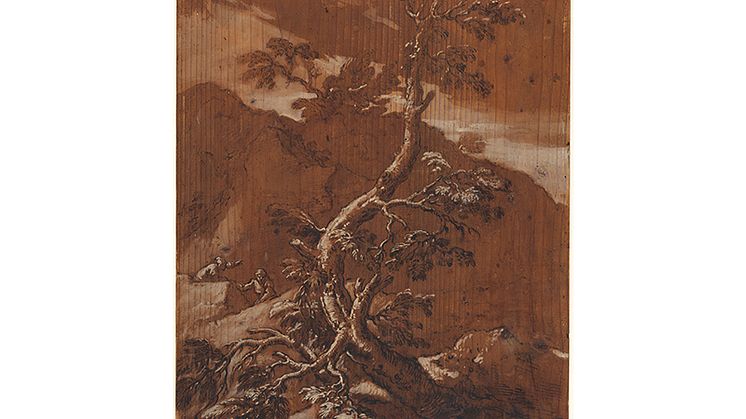
Press release -
New acquisition: Drawing by Italian master Salvator Rosa
Salvator Rosa, A Rocky Landscape with a Tree and Two Figures
Nationalmuseum has acquired a work by one of the foremost Italian artists of the seventeenth century, Salvator Rosa (1615-1673). The work belongs to a distinct and important category within Rosa’s artistic production, his panel drawings. With the acquisition, Nationalmuseum is now second only to the Pitti Palace in Florence in having such a distinguished collection of this type of work by the artist.
Salvator Rosa was both one of the most prominent Italian artists of the seventeenth century and one of the most unconventional. He pursued the visual arts, as well as poetry and acting. He was very well read and his art often had a literary source. Rosa often portrayed historical and mythological motifs in unexpected and innovative ways. Though he frequently selected obscure, seldom depicted aspects of well-known stories, he was nonetheless able to capture their essence.
Rosa was also influential in the development of landscape painting. Like his other work, Rosa’s landscapes featured biblical and mythological motifs. In addition, he painted landscapes of a type that came to be known as “Paesaggio con banditi” or “Landscape with bandits”. In these works, bands of bandits travel through open landscapes with vistas taken from Campagnano, the lowlands near Rome; from the environs of his home town Naples; and from Abruzzo and Calabria. Here one senses a romanticized interplay between the bandits’ free-ranging lifestyle and the untamed countryside. Perhaps one even gets a sense of nature being imbued with spirituality, an impulse given fuller expression in the painting of the Romantic period. It is hardly surprising that Rosa’s work, especially his landscapes, would enjoy great popularity at the end of the eighteenth and beginning of the nineteenth centuries. This was especially true among artists representative of romantic landscape painting in England.
In the current work, Rosa has placed a gnarled tree at center in the foreground. Two figures, possibly bandits, can be seen on a rocky outcropping near the tree. To great effect, Rosa integrates the brown coloring and rough texture of the panel into his motif. He uses white accents to create dramatic lighting, possibly a depiction of the moment just before sunset.
The tree and rocks in the foreground seem almost to project outward from the panel as they are drawn in such contrast to the silhouetted mountain in the background.
Salvator Rosa’s panel drawings constitute a unique body of work with specific qualities that provide an interesting comparison to the remainder of his artistic production. Frequently, the panels used for the drawings were retrieved from wooden crates. It is also possible in some cases that Rosa made drawings to decorate the crates prior to their use, for example, in transporting artworks to his friend and benefactor Giovanni Batista Ricciardi. Earlier works of this type include Nationalmuseum’s The Abandoned Oedipus (NM 6839) and The Death of Empedocles, part of the Pitti Palace collection in Florence. The Oedipus motif can also be found in an engraving by the artist similar to the named drawing, while that of Empedocles can likewise also be found in a painting. Even so, both drawings appear to be fully conceived works in their own right — as is the recently acquired work. It is possible that these drawings originally served as conversation pieces intended to stimulate intellectual exchange with Ricciardi. Given that the drawings are rendered on a surface traditionally used for painting, works such as these have often been challenging to group in traditional categories. The dimensions of the current work match closely those of previously known works from this group.
New research about this type of work has emerged during the past few years, and in the near future, more will be shared in the publication “Art Bulletin of Nationalmuseum”.
Nationalmuseum has no public funding for new acquisitions of handicrafts and art. Rather, the collections are augmented through donations and grants from private foundations and funds. Recent acquisitions have been made possible through a generous donation from the Wiros Fund (Wiros-fonden).
Pencil and ink with white accents on panel, 61.1 x 39.9 cm
Accession number: NMH 219/201
For more information, contact:
Daniel Prytz, curator, daniel.prytz@nationalmuseum.se, +46 8 519 543 06
Mattias Robertson, pressansvarig, press@nationalmuseum.se, +46 767 23 46 32
Related links
Categories
Nationalmuseum is Sweden’s museum of art and design. The collections comprise older paintings, sculpture, drawings and graphic art, and applied art and design up to the present day. The museum building is currently under renovation and scheduled to open again October 13, 2018. In the meantime, the museum will continue its activities through collaborations both in Sweden and abroad. Nationalmuseum has partnerships with Svenska Dagbladet and the Grand Hôtel Stockholm.

